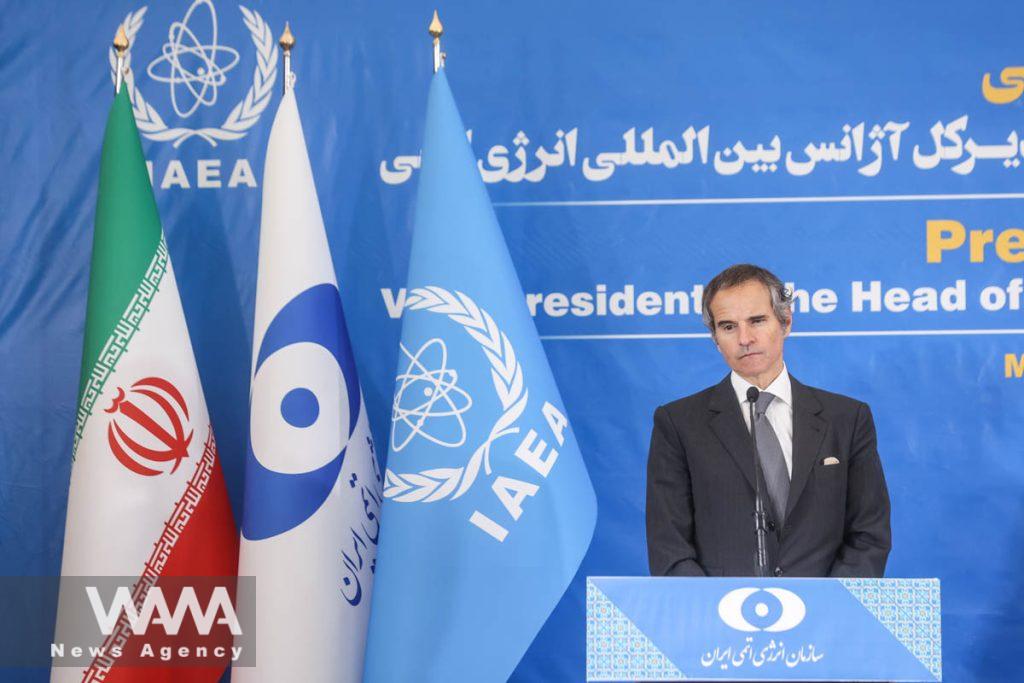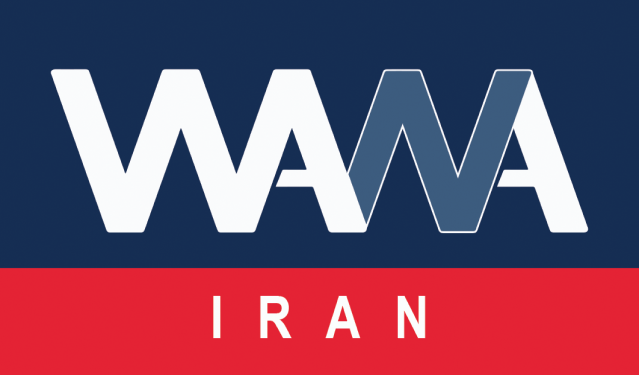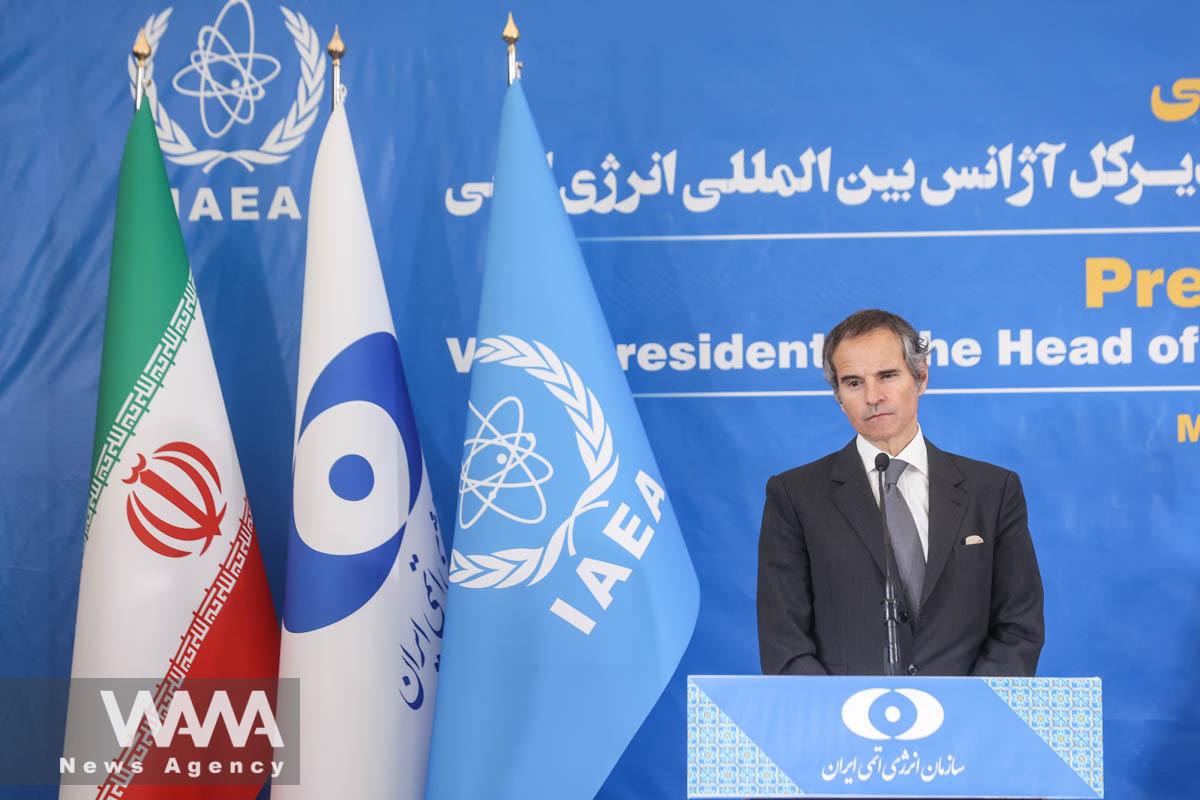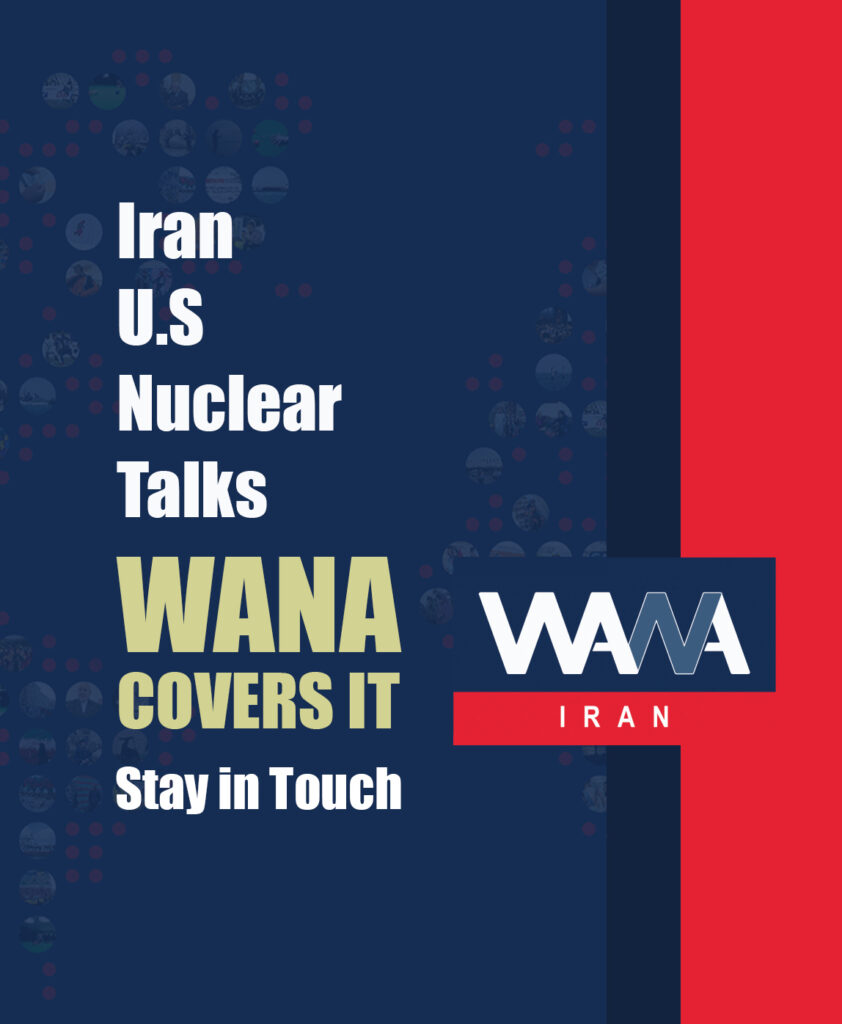No undeclared nuclear material in Iran; IAEA’s assertion based on Israeli lies: Iran’s mission
Iran’s permanent mission to the UN says there is no undeclared nuclear material in the country, saying the International Atomic Energy Agency’s assertion is based on “fabricated information” provided by the Israeli regime.

International Atomic Energy Agency (IAEA) Director General Rafael Grossi looks on during a news conference with Head of Iran’s Atomic Energy Organization Mohammad Eslami as they meet in Tehran, Iran, March 4, 2023. Majid Asgaripour/WANA (West Asia News Agency)
“As it was explained on many occasions to the Agency, there is no undeclared nuclear material in Iran, and the Agency’s assertion is merely based on false and fabricated information provided by illegitimate Israeli regime with a longstanding background of stringing chains of lies,” the Iranian mission said in an explanatory note to the IAEA dated June 5.
It said in light of further cooperation with the IAEA, Tehran has exhausted all its efforts to discover the origin of uranium particles found in Iran.
“Given the fact that Iran could not yet find any technical reasons for the presence of uranium particles, it would reasonably imply that possibly external elements, such as sabotage and malicious acts, have been involved in the contamination,” the mission asserted.
The following is the full text of the note provided by the Atomic Energy Organization of Iran:
Following the Report of the Director General, entitled: “NPT Safeguards Agreement with the Islamic Republic of Iran” (GOV/2023/26, 31 May 2023), the Permanent Mission of the Islamic Republic of Iran to the United Nations Office and other International Organizations in Vienna would like to share its comments and observations on the report as follows:
A. General comments:
1. The Islamic Republic of Iran is determined, as has also shown so far, to comply with its obligations under the Comprehensive Safeguards Agreement (INFCIRC/214) and it has done its utmost to enable the Agency to continue its verification activities in Iran, which is unique in the Agency’s verification system.
2. On the issue related to the so-called three locations, it should be highlighted that the origin of the issue goes back to the fabricated information provided to the Agency by an ill-intended third party, namely the Israeli regime, which does not accept to have a single commitment under any WMD instruments, including in particular the NPT, and repeatedly threatens to attack Iran’s nuclear facilities devoted to peaceful purposes, contrary to the numerous IAEA and UNGA resolutions.
B. Comments on the report, Background:
3. Paragraph 2 of the report states that: “The Agency is seeking explanations from Iran… at three undeclared locations …” is contrary to Paragraph 18 of the report which reads: “… The Agency at this time has no additional questions on the depleted uranium particles detected in ‘Marivan’ or on the location, and the matter is no longer outstanding at this stage.” Therefore, the number of locations is no longer 3. This is also the case for paras.4 and 7 of the report.
• As explained frequently by the Islamic Republic of Iran (e.g.: INFCIRC/996 dated 7 June 2022 and INFCIRC/967 dated 3 December 2021), there has not been any undeclared location which is required to be declared under the CSA. Iran’s nuclear activities remain peaceful under the Agency’s full-scope safeguards. Therefore, there is no legal basis for expressing “deep concern” by the Director General.
• The mere finding of natural uranium particles in environmental samples at a location cannot be considered as an indication that a quantity of nuclear material had been presented at that location.
• As it was explained on many occasions to the Agency, there is no undeclared nuclear material in Iran, and the Agency’s assertion is merely based on false and fabricated information provided by illegitimate Israeli regime with a longstanding background of stringing chains of lies.
• In light of further cooperation with the Agency, Iran has exhausted all its efforts so as to discover the origin of such particles. Iran has explained its assumptions about the probable causes of the presence of uranium particles. Given the fact that Iran could not yet find any technical reasons for the presence of uranium particles, it would reasonably imply that possibly external elements, such as sabotage and malicious acts, have been involved in the contamination.
4. The report further states in paragraph 3 and related footnote, “… unless and until Iran provided technically credible explanations for the presence of the aforementioned uranium particles at the three undeclared locations in Iran and informed the Agency of the current location(s) of the nuclear material and/or of the contaminated equipment, the Agency would not be able to confirm the correctness and completeness of Iran’s declarations under its Safeguards Agreement.” It should be noted that:
• The mere presence of a few uranium particles at the claimed locations could not be considered as presence of nuclear material or contaminated equipment. It should be noted that the Agency has not provided Iran with any authentic supporting documents for its claim.
• As explained by the Islamic Republic of Iran in numerous occasions, there has never been any undeclared location which is required to be declared under the CSA. Furthermore, based on our intensive investigations into the background of activities carried out in two remaining locations has not yet been found. There has not been any nuclear activity or storage in these locations. Therefore, as yet no technical explanation concerning the origin of reported particles were found, however, the possibility of presence of such particles by the sabotage acts cannot be excluded.
5. The Agency’s claim in footnote 7 that “… some of the containers stored at Turquzabad were dismantled at the location, others were removed from Turquzabad intact in 2018 and moved to an unknown location …” is not based on authentic information and evidence. Turquzabad is actually an industrial place encompassing various kinds of warehouses and depots for storing detergents, chemicals, foodstuffs, fabrics & textiles, vehicle tires and parts, tubes & joints and some industrial scraps. Movement of containers in and out of such an area is a usual activity; therefore, the claim of containers removal cannot be considered a ground for such an allegation. Despite the lack of solid and authentic documents, Iran granted, on a voluntary basis, complementary access to the locations for the Agency. This clearly indicates Iran’s willingness to address any possible ambiguity along with its full transparency.
6. Regarding paragraph 7 of the report which states: “… This increase of knowledge of Iran’s nuclear-related activities and the resolution of the outstanding safeguards issues is indispensable for the Agency to be able to provide credible assurances of the peaceful nature of Iran’s nuclear programme”. It should be noted that:
• Iran’s nuclear-related activities, such as the production and inventory of centrifuges, rotors, and bellows, heavy water, and UOC, are entirely out of scope of the CSA. Any measure in this regard is voluntary and related to commitments under the JCPOA.
• According to the CSA, there is no link between the assurances of the peaceful nature of Iran’s nuclear programme and the increasing of knowledge of Iran’s nuclear-related activities. Therefore, the Agency’s statement about the “increase of knowledge of Iran’s nuclear-related activities… to be able to provide credible assurances of the peaceful nature of Iran’s nuclear programme” has no legal basis and cannot be accepted.
C. Comments on the report, Implementation of the Joint Statement of 4 March 2023:
7. The Agency’s report states in paragraph 12of the report”…the Agency verified at the Uranium Conversion Facility (UCF) the dissolution of 302.7 kg of natural uranium, as declared by Iran, in the form of solid waste and items of uranium metal transferred from the Jaber Ibn Hayan Multipurpose Laboratory (JHL). The Agency identified a discrepancy that needs to be resolved in the amount of nuclear material it had verified compared to the amount declared by Iran”. It should be noted that:
• The uranium metal received at the Uranium Conversion Facility (UCF) from the JHL, has been frequently reported to the Agency by the operator and verified by the Agency since 2003, for which the relevant 90(a) and 90(b) statements have also been subsequently provided by the Agency stating its satisfaction. Furthermore, this material has been under the Agency’s continuous C/S measures since 2003 while it was retained at the JHL facility and it was still sealed while it was transferred to the UCF. Furthermore, there has not been any activity performed on this material that may change its status.
• Although the transferring, dissolving, and processing of the concerned material has been in the presence of the Agency inspectors, they have taken volume and density data of the dissolved material, but after completion of activities, they raised a doubt on measurement using an imprecise, nonconventional method that is not expressed in the facility’s Safeguards Approach with a reversed calculation based on U-236 isotopes to estimate dissolved material. Since the base of this measurement has not been accurate (there is a large difference between measures in 2003 and 2022) and is associated with high errors, this method of reveres calculation has not been accepted by the operator instead of the direct measurement that has been performed in the presence of the Agency inspectors.
• Therefore, the operator declaration on March 2022, for the uranium content in the four UNH batches before their blending (total 109.847 kg U), which was verified at the same time by the Agency inspectors, has been taken as the basis for the accountancy reports of the UCF facility, and there is no need for any correction on the nuclear material accounting records and reports.
8. On ‘Marivan/ Abadeh’ and the allegations about explosive experiments with protective shielding in preparation for the use of neutron detectors Iran maintains its position as referred in its explanatory note, and takes positive note of conclusion made by the DG that “the Agency at this time has no additional questions on the depleted uranium particles detected at ‘Marivan’ or on the location, and the matter is no longer outstanding at this stage.” Furthermore, it should be emphasized that other allegations which are not CSA matter are not accepted and completely rejected. In this regard following explanation should be noted:
• The Agency has referred to safeguards-relevant information available to it related to the ‘Marivan /Abadeh’ as supporting documents about this location, which refer to only two unauthentic images from an unknown location that cannot be referenced as evidence, because they are easily producible, forgeable and prepareable.
• Recall as it has been said many times that protecting shielding for the use of neutron detectors has principally no safeguards ground (based on article 2.8 and 69 of the CSA) and the Agency’s questions were not based on authentic information relevant to the purpose of safeguards for its request of access to the location, the Islamic Republic of Iran based on goodwill voluntarily granted access to the Agency and provided explanations regarding complete history, usage and even the application of bunkers which does not mean that it has been accepted as a safeguards issue.
• Despite this extensive cooperation, the Agency has considered the information received from Iran as inconsistent with the said alleged documents, just by reliance on some unauthentic and fabricated documents and then running into fallacious and invalid conclusion upon its own assumptions.
• The Agency’s claim that “Iran conducted explosive experiments with protective shielding in preparation for the use of neutron detectors and nuclear materials” is a baseless accusation without any authentic supporting evidence. This conclusion is absolutely false, unrealistic and biased. Furthermore, surprisingly without providing any authentic evidence the Agency report (GOV/2022/26 para 13) which says “… may have planned to use nuclear material … outdoor testing of conventional explosive …” had changed to “… planned to use and store nuclear material at ….for explosive testing.” (in the Agency’s report (GOV/2023/9, Para. 4) and finally has changed to “explosive experiments with protected shielding in preparation for the use of neutron detectors and nuclear material”. This inconsistency in the DG’s report shows that this allegation has no technical basis and cannot be accepted.
9. The Agency’s report states in paragraph 23 “… As part of this process, the Agency expects to be able to start to address, without further delay, access to data recordings and the gaps in the recordings’”. It should be noted that:
• As a principle, implementation of further verification and monitoring activities at workshops in Esfahan where centrifuge rotor tubes and bellows are manufactured, are entirely remained in scope of JCPOA on a voluntary basis and is out of obligations under the CSA.
• Morover, all transparency measures under the JCPOA have been ceased by a law passed by the Parliament entitled “Strategic Action to Remove Sanctions and Protect the Interests of the Iranian Nation”, in response to illegal unilateral withdrawal as well as outright violation of the JCPOA by the US.
• According to aforementioned facts, the Agency’s request to access to the data recorded by the cameras during period between February 2021 and June 2022 as well as those data recorded since 2-3 May 2023 currently are not subjected to the Joint Statement.
D. Comments on the report, Modified Code 3.1:
10. Regarding the implementation of modified Code 3.1 of the subsidiary Arrangements, it should be reminded that acceptance of implementation of modified code 3.1 was among those transparency and confidence building measures, reflected in paragraph 65 of the JCPOA. Following the US withdrawal from the JCPOA and failure of the E3/EU to fulfill any of their commitments within the JCPOA, Iran in response ceased all transparency measures beyond its Comprehensive Safeguards Agreement. Based on this fact, implementation of modified code 3.1 was suspended. Therefore, the Agency’s reference to Article 39 of the CSA has no legal basis.
E. Comments on the report, Summary:
11. The Agency’s report states in paragraph 28 “the remaining outstanding safeguards issues stem from Iran’s obligations under the Comprehensive Safeguards Agreement between Iran and the Agency and need to be resolved for the Agency to be in a position to provide assurance that Iran’s nuclear programme is exclusively peaceful”. It should be noted that:
• Since the Agency has not presented authentic documents to Iran concerning its claim on “undeclared nuclear material and nuclear-related activities”, Iran did not oblige itself to consider unauthentic and fabricated documents as CSA basis to respond the Agency’s requests. However, Iran voluntarily granted access and provided information and clarification to the Agency on these locations.
• It is regrettable that the Agency considers all fabricated documents and fake information provided by the Israeli regime as authentic, and concluded that “…need to be resolved for the Agency to be in a position to provide assurance that Iran’s nuclear programme is exclusively peaceful”. Such statement undermines impartiality of the Agency and is far from the professional approach need to be taken by the Agency.
F. Conclusion:
1. The Islamic Republic of Iran has so far rendered its full cooperation under the CSA to the Agency. It has to be re-emphasized that all Iran’s nuclear material and activities have been completely declared and verified by the Agency.
2. The Islamic Republic of Iran strongly expects that the Agency conduct its reporting on verification activities in Iran based on the principals of impartiality, professionalism and objectivity.
3. The Agency should not disregard the possibility of involvement of Iran’s staunch enemies in providing false and fabricated information and committing various sabotage acts.
4. The verification activities related to the JCPOA such as production and inventory of centrifuges, centrifuge rotor tubes and bellows, heavy water and uranium ore concentrate (UOC) are not under the CSA scope. Therefore, linking the assurances of the peaceful nature of Iran’s nuclear program and resolution of the alleged issues to such information are baseless and unacceptable.
5. While all Iran’s nuclear material and activities have been under Agency’s strict verification and monitoring activities coupled with Iran’s cooperation and voluntary transparency measures, questioning the peaceful nature of Iranian nuclear program has no justification.
6. The Islamic Republic of Iran, once again, stresses that the current extensive level of its cooperation with the Agency has not been achieved easily, just to be diminished by short-sighted political interests. Accordingly, all including the Agency and the Member States, have the responsibility to show wisdom in addressing such issues in a diligent manner in order to avoid distorting the bigger picture on cooperation between Iran and the Agency.
SOURCE: IRNA












